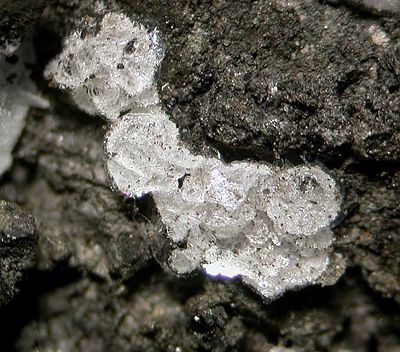Ravatite
| Ravatite | |
|---|---|
| Ravatite from the Anna dump near Alsdorf , North Rhine-Westphalia, Germany | |
| General and classification | |
| other names |
IMA 1992-019 |
| chemical formula | C 14 H 10 |
|
Mineral class (and possibly department) |
Organic compounds |
|
System no. to Strunz and to Dana |
10.BA.40 ( 8th edition : IX / B.02) 03.50.02.01 |
| Crystallographic Data | |
| Crystal system | monoclinic |
| Crystal class ; symbol | monoclinic sphenoid 2 |
| Room group (no.) | P 2 1 (No. 4) |
| Lattice parameters |
a = 8.39 Å ; b = 6.18 Å; c = 9.56 Å β = 98.5 ° |
| Formula units | Z = 2 |
| Physical Properties | |
| Mohs hardness | 1 |
| Density (g / cm 3 ) | 1.11 |
| Cleavage | perfectly |
| colour | colorless, white, pale gray |
| Line color | White |
| transparency | transparent to translucent |
| shine | Glass gloss, wax gloss |
| Crystal optics | |
| Refractive indices |
n α = 1.750 n γ = 1.950 |
| Birefringence | δ = 0.200 |
| Optical character | alternating biaxially |
| Axis angle | 2V = 90 ° |
Ravatite (chemically phenanthrene ) is a very rare mineral from the mineral class of organic compounds . It crystallizes in the monoclinic crystal system with the chemical composition C 14 H 10 and thus belongs to the hydrocarbons .
Ravatite mainly develops leafy, polycrystalline crystals about 0.1 mm in size, but also porous, irregular aggregate forms and crusty coatings that are either colorless or white to pale gray in color and glassy to waxy sheen . The line color of the ravatite, however, is always white.
Its Mohs hardness is 1, which means ravatite is soft like talc and can be scratched with a fingernail. With a density of 1.11 g / cm³, the mineral is only slightly denser than water (1 g / cm³).
Etymology and history
Ravatite was first found and described in 1993 by Nasdala and Pekov. They named the mineral after its type locality Ravat in the Gissar Mountains / Sughd in Tajikistan .
classification
In the old systematics of minerals according to Strunz (8th edition) , ravatite can be found under the "nitrogen-free hydrocarbons". However, since the new Strunz'schen mineral classification , the mineral class of organic compounds has been rearranged and further subdivided. Ravatit therefore now belongs to a not yet named subdivision 10.BA of the “Hydrocarbons” department.
The systematics of minerals according to Dana , which is mainly used in the English-speaking world , also sorts ravatite into the section of "organic minerals". Here the mineral is the namesake of the "Ravatitgruppe" with the system no. 50.03.02 within the subdivision of " Salts of organic acids and hydrocarbons ".
Crystal structure
Ravitite crystallizes in the monoclinic crystal system in the space group (space group no. 4) with the lattice parameters a = 8.39 Å ; b = 6.18 Å; c = 9.56 Å and β = 98.5 ° and 2 formula units per unit cell .
Education and Locations
Ravatite is seldom formed by resublimation from burning coal at around 50 ° C to 60 ° C ( coal fire ). Accompanying minerals are salmiak and hematite .
So far, the mineral has only been found in three locations, near Alsdorf and Freital in Germany and its type locality Ravat in Tajikistan.
See also
Individual evidence
- ↑ Webmineral - Ravatite (Eng.)
- ^ A b Hugo Strunz , Ernest H. Nickel: Strunz Mineralogical Tables . 9th edition. E. Schweizerbart'sche Verlagbuchhandlung (Nägele and Obermiller), Stuttgart 2001, ISBN 3-510-65188-X , p. 724 .
- ↑ a b c Ravatite at mindat.org (engl.)
- ↑ L. Nasdala, IV Pekov: Ravatite, C 14 H 10 , a new organic mineral species from Ravat, Tadzhikistan . In: Eur. Jour. Mineral. , 1993, 5, pp. 699-705., Abstract in: American Mineralogist , 1994, 79, p. 389 pdf .
- ↑ New Dana Classification of Organic Minerals (Eng.)
- ^ Hugo Strunz , Ernest H. Nickel: Strunz Mineralogical Tables . 9th edition. E. Schweizerbart'sche Verlagbuchhandlung (Nägele and Obermiller), Stuttgart 2001, ISBN 3-510-65188-X , p. 724 .
Web links
- Mineral Atlas: Ravatite (Wiki)
- Mineral data sheet Ravatite (English, PDF 64.9 kB)


